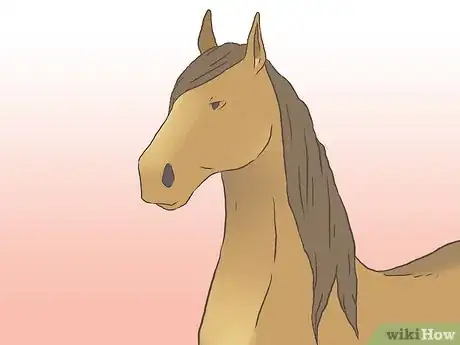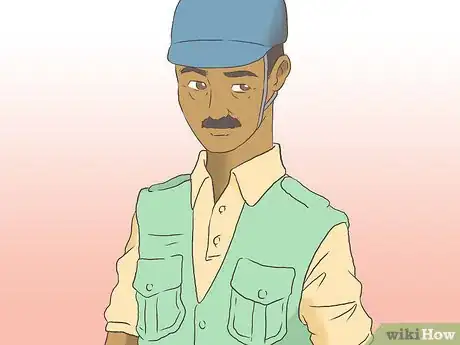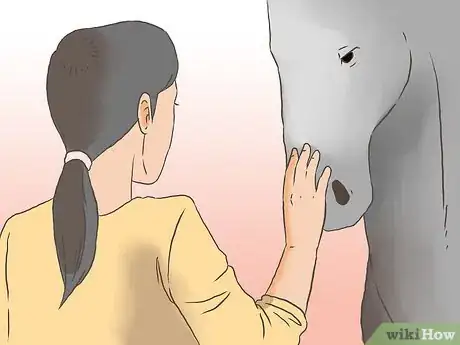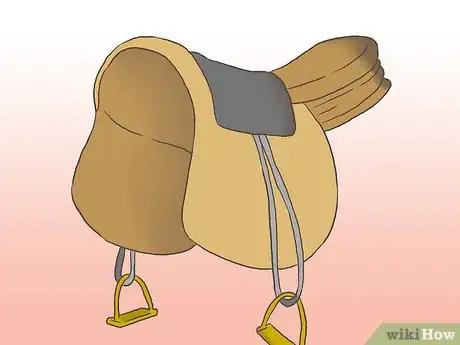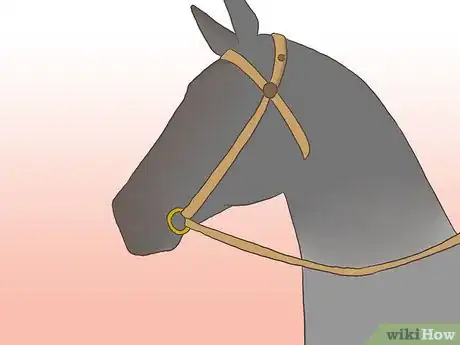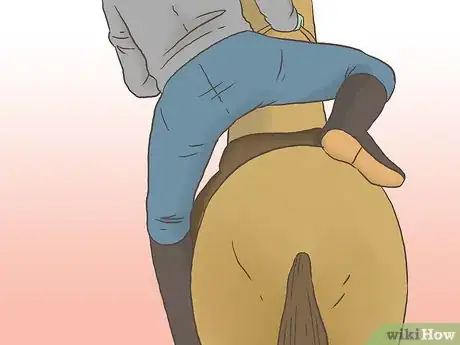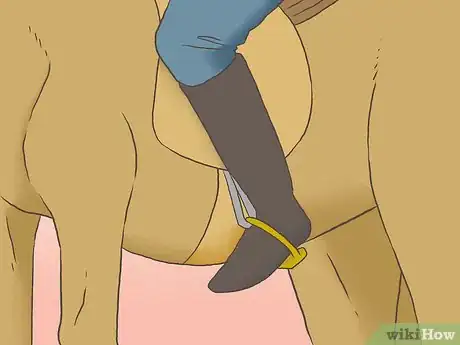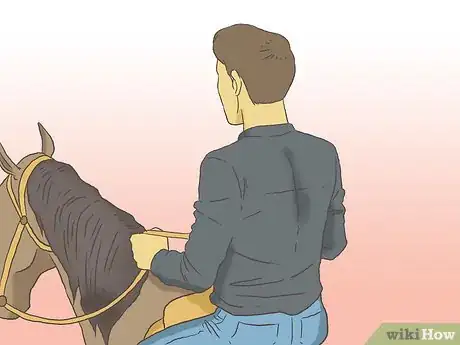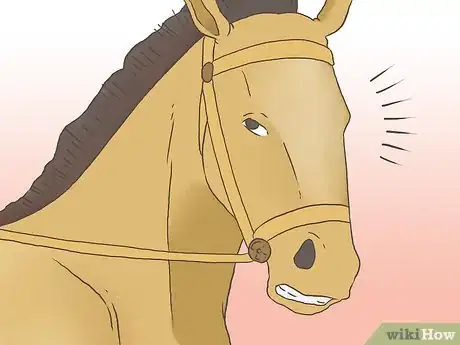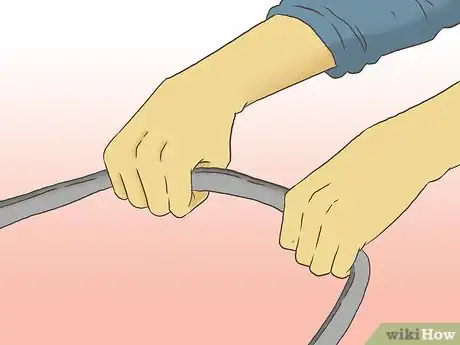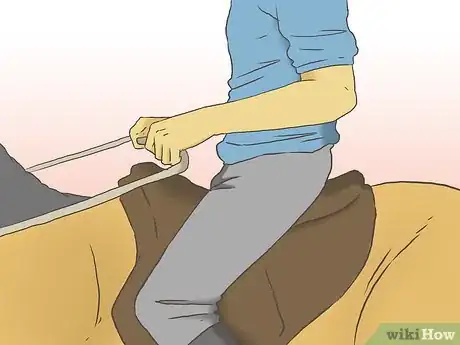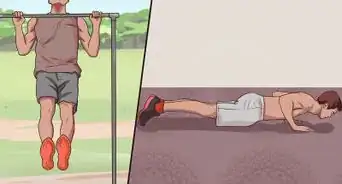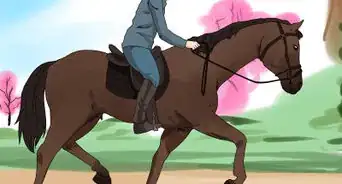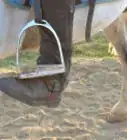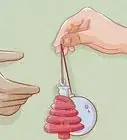This article was co-authored by Alana Silverman. Alana Silverman is a Certified EAGALA (Equine Assisted Growth and Learning Association) Equine Specialist and the Assistant Manager of Paddock Riding Club, a 200-horse premier equestrian facility based in Los Angeles, California. Alana has over 25 years of experience caring for and riding horses and specializes in English riding and riding instruction. She has a BA in Psychology from the University of Arizona.
This article has been viewed 56,234 times.
We've all seen people that appear to effortlessly ride horses. They may just be on television, but it is possible to enjoy a gentle ambling ride in real life. Gaited horses are well-known for being smooth to ride and are good for beginners. Do your research as to the specific kind of gaited horse you want to ride; their gaits are unique. Once you've positioned yourself correctly on your horse, you're ready to communicate and ride. With any luck, you'll be riding effortlessly too!
Steps
Preparing to Ride
-
1Choose what kind of horse you want to ride. Be aware that there are many types of gaited horses that vary considerably. Here are just a few of the most popular:
- American Saddlebred - known for stylish presence and gentleness
- Missouri Fox Trotter - known for its stamina, useful for trail riding or ranch work
- Paso Fino - varies by kind, but can be favored for shows or trail rides
- Tennessee Walker - has a flashy movement, but calm disposition
-
2Take a few lessons. Once you've decided what kind of gaited horse you'd like to ride, find someone that offers lessons with the specific kind of horse you've chosen.
- Taking lessons from an instructor can help you become more comfortable with your horse, safer on the trails, and a better rider in general. Don't assume that lessons only teach show tricks.[1]
Advertisement -
3Find a horse to practice riding. At the stables, look for a gaited horse that is gentle, already trained to carry a rider, and has been used for trails.
- Pick a horse that you connect with and you won't regret it. A happy horse won't try to throw its rider or impatiently mouth the bit at all times. Riding should be an enjoyable experience for horse and rider.
-
4Get a saddle and bridle. Some gaited horses tend to have high withers so you might need to purchase a saddle with a high swell on the front. It can be very uncomfortable for any horse to wear an improperly fitting saddle.
- The ridge between the horse's shoulder blades is the withers. Set the saddle slightly forward over the withers, then let slip it back till it seems to come to a natural stop. Your horse should not mind wearing the saddle; if it shows discomfort, readjust the saddle.[2]
- Always place a saddle pad on your horse's back before putting the saddle on.[3]
- Make sure the saddle is on properly with the girth secure before you start riding.[4]
-
5Find a well-fitting headstall and bit. Choose gear that is the most comfortable for your individual horse. Don't choose a bit based on breed or gait.[5]
- Get advice from a professional or ask the previous owners what bit they used. Try a few different ones till you discover what your horse prefers.
- If you're taking lessons or just riding at a stable, chances are you won't need to worry about the headstall, bit, or saddle. They'll already be chosen and the horse will be used to the equipment.
- Your local tack shop should have a bit sizers for sale that can help you figure out your horse's bit size.[6]
Understanding Your Posture and Balance
-
1Mount up! Stand next to your horse or on your mounting block and hold the reins in your left hand. Place your left foot in the stirrup and swing your right leg over the horse. Gently lower yourself into the saddle.
- If someone is giving you a leg-up, place your left foot into the stirrup and hold the front of the saddle, or pommel. Pull yourself up and swing your leg over before gently lowering yourself into the saddle.
-
2Let your legs hang naturally. Avoid the urge to grip your horse with your legs. This will send confusing messages to your horse. Your legs should gently touch the horse's sides while your knees are bent and your heels are lower than your toes.[7]
- If you find yourself continuing to grip the sides of the horse with your legs, check to make sure your stirrups are properly adjusted.
-
3Sit straight up with your shoulders, hips, and heels aligned. This will evenly distribute your weight, making it easier for your horse to carry you. You should be able to imagine a straight line running from your ear, shoulder, hip, and heel.[8]
- If you are out of alignment, your horse will find it difficult to carry you for long. You may notice your horse becoming uncomfortable or changing his gait to accommodate you.
-
4Keep your back relaxed. While your back should be straight, make sure not to arch your spine. The curved spine will make you sit too far forward which can tire you and your horse.[9] An arched spine can lead to overall tension.
- When you're tense, your horse will become tense as well. This can cause it to speed up or run off and make you unnecessarily tired and sore.[10]
Communicating With Your Horse
-
1Relax. This may seem like a strange way to begin riding, but realize that your horse will pick up on any tension or anxiety. When you're relaxed, your horse will relax too, allowing its joints and muscles to become more flexible.
-
2Hold the reins firmly, but don't pull. This lets your horse know that you're there. Be sure not to pull tightly on the reins, though. The horse will need space in order to move its head.
- Use gentle hands to communicate through the reins. Work with a bit of slack in the reins. Your horse will pick up on the slight vibrations in the reins. If you constantly pull on your horse, it will become desensitized.
-
3Guide the horse with your body. Use your pelvic muscles to suggest a direction to your horse. Drive your pelvis forward or backward to encourage your horse in those directions.
- Developing these cues will take time and practice. Keep working with your horse to create this intuitive method of instruction.
-
4Talk to your horse. Use simple verbal cues to back up physical cues. For example, you can encourage your horse to move and stop by saying, "walk," "whoa," or "ho."
- Be consistent in giving verbal directions. You should also give positive encouragement and support when your horse follows through with a direction. You can say, "good horse/boy/girl," or rub its neck.
Community Q&A
Did you know you can get expert answers for this article?
Unlock expert answers by supporting wikiHow
-
QuestionHow can I adjust my equipment so riding is less uncomfortable?
 Jessica RudeJessica Rude is an Equine Expert currently working on a cutting horse ranch in Valley View, Texas as well as a horseback riding center in Princeton, Texas. Previously, she was a Trail Guide and Wrangler at a camp and retreat center In Dallas, Texas, and an Equine Breeding Barn Manager at a reining ranch in Tioga, Texas. Jessica holds a Bachelor’s degree in Animal Science with an emphasis in Equine Science from Tarleton State University. She has studied equine nutrition, reproduction, and management. Jessica specializes in equine breeding as well as instructing horseback riding lessons, leading trail rides, recognizing equine illnesses, and administering treatments.
Jessica RudeJessica Rude is an Equine Expert currently working on a cutting horse ranch in Valley View, Texas as well as a horseback riding center in Princeton, Texas. Previously, she was a Trail Guide and Wrangler at a camp and retreat center In Dallas, Texas, and an Equine Breeding Barn Manager at a reining ranch in Tioga, Texas. Jessica holds a Bachelor’s degree in Animal Science with an emphasis in Equine Science from Tarleton State University. She has studied equine nutrition, reproduction, and management. Jessica specializes in equine breeding as well as instructing horseback riding lessons, leading trail rides, recognizing equine illnesses, and administering treatments.
Equine Expert
-
QuestionCan a 10 year old kid ride a gaited horse ?
 Allison ThomsonCommunity AnswerYes, they can. But make sure they are wearing a helmet and body protector, as some gaited horses may become lively (like every other horse on the planet).
Allison ThomsonCommunity AnswerYes, they can. But make sure they are wearing a helmet and body protector, as some gaited horses may become lively (like every other horse on the planet).
Warnings
- Some gaited horses are known as "hot-blooded." While these energetic horses might settle down with age or trust in the rider, they can be too much to handle for a beginner or timid rider. So get a calm, experienced gaited horse.⧼thumbs_response⧽
- Be careful! Gaited horses, mainly young horses, can be very spirited and frisky.⧼thumbs_response⧽
References
- ↑ http://trailridermag.com/article/ride-right
- ↑ http://www.thehorse.com/articles/15102/fitting-the-saddle-to-the-withers
- ↑ Alana Silverman. Certified EAGALA Equine Specialist. Expert Interview. 17 March 2020.
- ↑ Alana Silverman. Certified EAGALA Equine Specialist. Expert Interview. 17 March 2020.
- ↑ http://trailridermag.com/article/gaited-horse-bits-15294
- ↑ Alana Silverman. Certified EAGALA Equine Specialist. Expert Interview. 17 March 2020.
- ↑ http://trailridermag.com/article/ride-right
- ↑ http://www.equisearch.com/article/riding-perfect-position-15651
- ↑ http://www.equisearch.com/article/riding-perfect-position-15651
